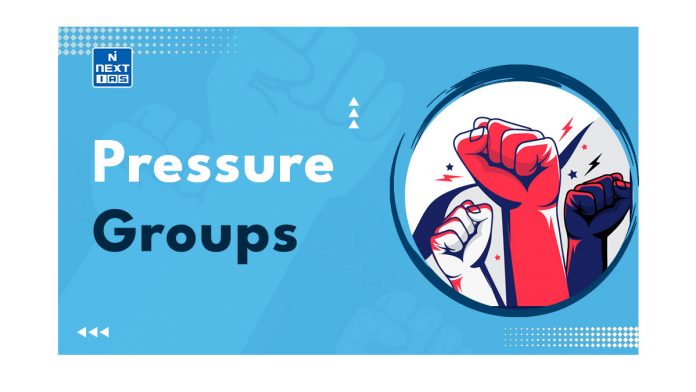Pressure groups are organized groups of people who actively work together to promote and defend their common interests. They aim to bring about changes in public policies by putting pressure on the government. They act as a link between the government and their members.
What are Pressure Groups?
- They are also known as interest groups or vested groups and are different from political parties. They don’t participate in elections or seek political power.
- Their focus is on specific programs and issues, and they work to protect and promote the interests of their members by influencing the government.
- These groups influence government policies through legal and legitimate methods such as lobbying, correspondence, publicity, petitions, public debates, and maintaining contact with legislators.
Techniques Used by Pressure Groups to Achieve their Goals
- First is electioneering, which involves supporting candidates who are favorable to the group’s interests and getting them elected to public office.
- Second is lobbying, where pressure groups try to persuade public officials to adopt policies that align with their interests, regardless of their initial stance.
- The third technique is propagandizing, which involves influencing public opinion to indirectly influence the government, as governments in democracies are influenced by public sentiment.
Role of Pressure Groups in India
- One of the main roles is to represent the voices of ordinary people and advocate for the concerns of minority groups who often go unheard.
- These groups consist of experts in their respective fields who provide the government with relevant information to work toward the improvement of society.
- They can also serve as an alternative source of advice for the government.
- They focus on advocating for the rights and freedoms of individuals, whether in a specific profession or on legal grounds
- They play an important role by acting as a bridge between the government and the public.
- They help ensure that the government pays attention to the needs and desires of the community.
Pressure Groups have Certain Characteristics
- They are organized based on specific interests and adopt power structures within the political system.
- They use both modern and traditional methods, such as financing political parties, sponsoring candidates, and appealing to caste, creed, or religious sentiments.
- They emerge due to increasing demands and competition for limited resources in society.
- They also arise from the inadequacies of political parties.
Types of Pressure Groups
| Institutional Pressure Groups: These groups consist of professionally employed individuals and are part of the government machinery. They aim to exert their influence through constitutional means. Example: IAS association, IPS association |
| Associational Pressure Groups: These specialized groups pursue specific goals and interests. They include trade unions, organizations of businessmen and industrialists, and civic groups. Business groups: FICCI, ASSOCHAM, FAIFDA Trade unions: AITUC, INTUC, HMS, BMS |
| Anomic Pressure Groups: These are spontaneous groups that enter the political system through actions such as riots, demonstrations, and assassinations. Example: Naxalite Groups, JKLF, ULFA |
| Non-Associational Pressure Groups: These informal groups articulate interests based on kinship, ethnicity, region, status, and class. They include caste groups, language groups, and more. Caste groups: Harijan Sevak Sangh, Nadar Caste Association Religious groups: RSS, VHP, Jamaat-e-Islami Linguistic groups: Tamil Sangh, Andhra Maha Sabha Tribal groups: NSCN, TNU, United Mizo Federal Org, Tribal League of Assam |
Several Functions and Important Roles Played by Pressure Groups
- They articulate the demands and needs of the people to decision-makers.
- They also act as agents of political socialization, shaping people’s political orientations and serving as communication links between the people and the government.
- They are involved in the legislative process, lobbying for laws and amendments that align with their interests.
- They also interact with the bureaucracy to influence policy implementation.
- They utilize the judicial system to protect their interests and seek redressal for grievances.
- Additionally, they help shape public opinion, improve government quality, provide checks and balances, bring new concerns to the political agenda, and contribute to social cohesion and stability.
Shortcomings of the Pressure Group
- In India, some groups are organized around narrow selfish interests, such as religion and caste, rather than broader socioeconomic concerns.
- They can be misused as tools for political interests and may resort to violence or unconstitutional means.
- Due to a lack of autonomous existence pressure groups become unstable and lack commitment, leading to a shift in loyalties with a change in political situation which threatens the general welfare.
Conclusion
They have become essential in democratic processes. As society becomes more complex, individuals need to unite with others who share their interests to have greater influence. Consultation, negotiation, and some bargaining are necessary for democratic politics, and governments should consider and consult organized pressure groups during the policy.









